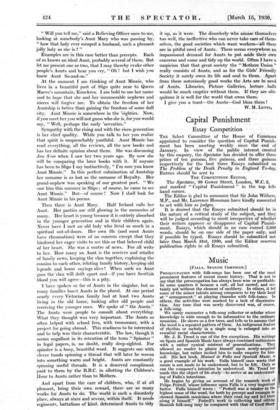Music
WALLA, SPANISH COMPOSER.] PREOCCUPATION with folk-songs has been one of the most prominent features of recent music history. That is not to say that the preoccupation has always been wise or profitable. In some quarters it became a cult, all but sacred, and cer- tainly not without the element of snobbery. In others, it led some of the Minor talents among composers to try their head at- arrangement," at, playing charades with folk-tunes. In I:others; the activities were marked by a lack of discrirnina- tkin. • Any tune that was newly discovered was, of Course, a folk7song. . . • -We rarely encounter a folk-song collector or scholar whose knowJedge. is.. wide enough. to be informative to the ordinary musician: --He shows us a few trees, and tells us to assume that the4niidis a repeated pattern of these. An indigenous feattire of iiiirthin or melody in a single song is enlarged into an essential- racial characteristic.
Mr. J. B. Trend is one of the few exceptions. His writings on Spain and Spanish Music 'have always combined enthusiasm with a rather cynical mistrust of generalizations. They allowed no reader to plume himself upon newly-acquired knowledge,- but rather incited . him to make enquiry for him- self: . self: His last book, Manuel de Falla and Spanish Music. is a good example of his work. Falla himself once wrote that music is not made to be understood, but to be felt. Only so can the composer's intention be understood. Mr. Trend has 'made this the object of his study—to arrive at an understand- ing of Falla's . intentions. He begins by giving an account of the research work of Felipe Pedrell, whose influence upon Falla is a very important factor: Fella himself wrote : Pedrell was a -master in the highest sense of the word, for both by precept' and example he .showed Spanish musicians where their road lay and leg them ,along it himself." Pedrell's 'work in collecting and editing 'Spanish folk-song may be compared -with that of Cecil Sharp
in connection with English folk-song and the relation between Pedrell and Falls is not unlike that between Sharp and Vaughan Williams.
Mr. Trend goes on to discuss the Spanish idiom. He points out that to _many ;people Spanish music is anything that conforms to the type defined by Bizet's Carmen, and Confirmed by Lido's Capriccio. This shallow notion is the cause of all the misunderstanding of serious modern Spanish music, According to Falla, three events have been influential hi determining the versatile character of Spanish music ; the Use of Byzantine liturgical music by the Spanish Church ; the Muslim invasion ; and the coming of the gipsies. We are warned against assigning too much importance to Moorish influence. Writers on the subject are too prone to use the Moors as a ready-made solution of any tiresome and obscure problem. The truth is that the Moors were influenced by the Spaniards, at least in some respects. Pedrell makes
this point when he writes : " Spanish music owes nothing essential to the Arabs or the Moors, who probably did no more than re-form certain ornamental figures common to the oriental and Persian systems from which Arab music was derived." But (to show how complex this problem is) Falla qualifies this opinion and finds in the dance music of the Moors of Andalucia, elements which are absent from Spanish liturgical music. He has also discovered in cante hondo (a group of Andalusian folk-songs) features which seem to correspond with some of the melodic types of India. This chapter goes on to develop the interesting theme in detail. It is the centre-piece of Mr. Trend's book, and students of Spanish music, will be grateful to the author for the lucid way in which he has stated his difficult case. Having set his historical background, Mr. Trend brings his -hero on to the stage. He is careful to throw upon him no glaring spotlight. Instead, he surrounds him with a skilfully contrived atmosphere borrowed from de In Mare's Arabia. In this setting of soft, dim light, the characteristics of Falla as a composer are sharply defined. We see him as the: evoking poet of his own province (Andalusia). We see Debussy in the misty background and realize their true relationship. At the beginning (" La Vida Breve ") Falls is not quite sure of his direction, but in the three Nocturnes for orchestra and pianoforte (1916) he strikes a personal attitude. •.Then follow " El Amor BrujO," in which he definitely establishes himself as a composer for the theatre, the "Fantasia Betica," dedicated to Arthur Rubinstein, and the ballet "The Three Cornered Hat," which will always remembered as one of the happiest achievements of the Diaghilev regime. Then we see him disguising his purely Spanish aspect in " The Puppet Show " and the Concerto for harpsichord and small orchestra, which was given in London in June, 1927. It is here that Mr. Trend shows his eleverness.as a stage manager, for, if we have understood him aright in the earlier chapters we shall see that these works are not so much disguises as revelations of the com- poser's essentially national spirit. To make the point a new character appears, Domenico Searlatti. He is given Spanish clothes to wear and we are content to think of him as a Spaniard. Then we see how alike these two are in their style and methods. " The passion is there, but it is always expressed with concision and clarity." That is Mr. Trend's observation. The words can equally well be applied to his ownpresentation of Manuel de Falla, Spanish composer. BASIL MAINE.





















































 Previous page
Previous page